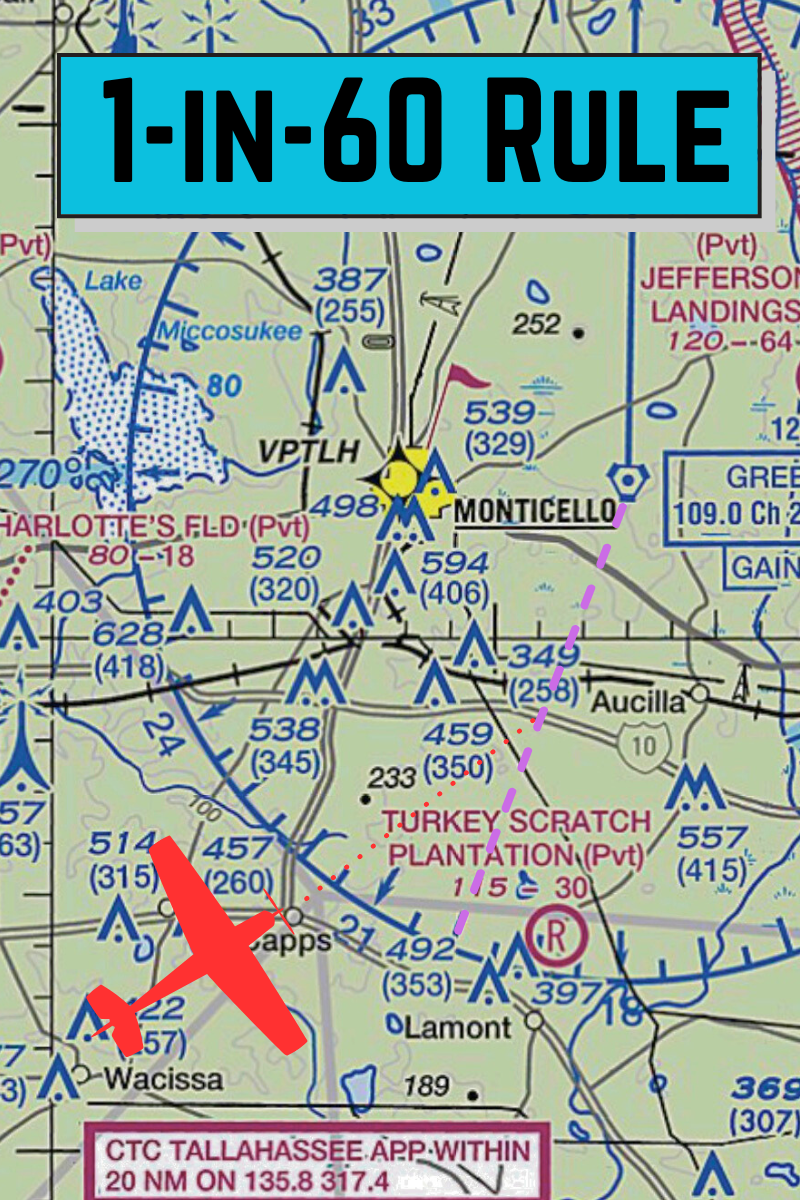
The 1-in-60 Rule in Aviation: How It Helps With Flight Navigation
By Richard L., CFI
Hello, pilots and student aviators!
Today we’re diving into one of my favorite old-school navigation tricks—the 1-in-60 rule. It’s simple, elegant, and incredibly useful—even in our age of GPS and moving maps. Whether you’re a student pilot working on your private pilot license or a seasoned flyer brushing up on fundamentals, this timeless rule can save you from straying off course (literally).
What Is the 1-in-60 Rule?
The 1-in-60 rule is a mental math shortcut that helps pilots estimate how far off course they are and how to correct their heading to get back on track.
Here’s the magic:
If you’re off course by 1 mile after flying 60 miles, you’re 1° off your intended track.
That’s it. One degree of heading error equals one mile of displacement at 60 nautical miles.
It’s called the “1-in-60” rule because of that simple relationship: 1 mile per 60 miles = 1°.
But what makes it so powerful is how you can scale it. You can use it for any distance, and it gives you a quick way to figure out both how far off course you are and how much to correct.
Why the 1-in-60 Rule Still Matters
You might be thinking, “I’ve got ForeFlight, GPS, and a magenta line—why do I need this?”
Here’s the truth:
Technology fails. Situational awareness doesn’t.
As a CFI, I’ve seen students panic when their tablet overheats or their panel GPS drops out mid-flight. Knowing how to navigate using basic principles—like the 1-in-60 rule—keeps you confident, composed, and safe.
Plus, understanding this rule helps you visualize what your airplane is actually doing in space. You’ll think in terms of degrees, distances, and corrections rather than just “following the magenta line.” That kind of awareness separates a good pilot from a great one.
The Math Behind the Magic
Let’s unpack it a little more.
Imagine you planned a leg from Point A to Point B, 60 nautical miles apart.
You fly the leg, and at your halfway checkpoint (30 NM), you notice you’re 2 miles right of course.
You can use the 1-in-60 rule to figure out your angular error:
So in this case:
You’re 4° off course.
Now, you need to get back on track. To correct, you double the error for a short time—so fly 8° left until you intercept your planned course—then resume the proper heading.
This “double-the-error” method works beautifully because it gets you back on course quickly and efficiently without overshooting.
Practical Example for Student Pilots
Let’s say you’re on a VFR cross-country from KPAE (Paine Field) to KBLI (Bellingham)—about 45 nautical miles.
After 15 miles, you note a ground reference checkpoint that’s 1 mile to your right.
Here’s how you’d apply the rule:
You’re 4° off course to the right.
To rejoin the line, you can correct 8° left until back on course (watch your landmarks and timing), then resume your planned heading.
This small, smart adjustment is the kind of piloting finesse that keeps you on track—and impresses your examiner during a checkride!
Using the 1-in-60 Rule in Reverse
You can also use it to estimate how far off course you’ll be if you fly the wrong heading for a given time.
For example:
If you accidentally fly 5° off course for 60 NM, you’ll be 5 miles off your intended path.
Or, if you’re 2° off course for 30 NM, your error is:
This helps with flight planning, fuel management, and knowing how small heading errors add up over long legs.
Applying It to Wind Corrections
In real-world flying, the 1-in-60 rule isn’t just for course deviation—it’s great for estimating wind drift.
When you’re doing preflight planning or noticing your ground track sliding sideways on your sectional, you can use the rule to mentally calculate how much the wind is pushing you off course.
For example, if after 10 miles you’re half a mile left of your intended path, you can estimate:
0.5 x 60/10 =3°
So the wind is causing a 3° drift—simply correct your heading 3° into the wind.
Why CFIs Still Teach This Rule
As instructors, we love tools that make navigation intuitive—and the 1-in-60 rule does exactly that.
It teaches students:
-
To visualize angles and distances in flight.
-
To recognize and correct small errors early.
-
To maintain situational awareness without total reliance on technology.
-
To think like a navigator—not just a GPS follower.
It’s also one of those FAA favorites that can pop up on your checkride oral exam or knowledge test, so it’s worth mastering early.
Memory Aid
Here’s an easy way to remember it:
“One in sixty, one degree—simple, quick, and navigation is easy!”
You can even jot it on your kneeboard or add it to your preflight checklist notes. Many pilots find it so handy they keep a small flight computer or nav log ready with quick conversion examples.
The 1-in-60 Rule and Modern Avionics
Even with ForeFlight, Garmin Pilot, or G1000 screens lighting up your cockpit, traditional navigation skills matter.
Understanding the geometry of flight paths makes you better equipped to interpret your instruments, spot errors early, and cross-check your tech.
Remember: every pilot is responsible for maintaining position awareness—even when automation fails.
Final Thoughts
The 1-in-60 rule is more than just a piece of aviation trivia—it’s a timeless navigation principle that builds your confidence and precision as a pilot.
So next time you’re on a cross-country and notice you’re a mile off, don’t panic. Take a breath, apply the 1-in-60 rule, make a smart correction, and smile—because you’re flying like a pro who understands the sky, not just the screens.
Fly safe, stay sharp, and keep learning.
By Richard L., CFI
If you’re a student pilot looking for helpful study tools and flight gear, NorthstarVFR.com is a trusted resource designed with your training in mind. We offer carefully curated pilot supplies and study materials, including our popular Pre-Tabbed FAR/AIM, Oral Exam Guides, kneeboards, logbooks, and more. Everything is selected to help you stay organized, pass your checkrides, and fly with confidence. Check it out and set yourself up for success in the cockpit.
